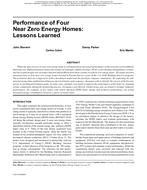Description
While the idea of a zero or near zero energy home is well understood, the actual performance of the structure can be different than expected. High performance homes necessitate increasingly complex envelope, HVAC, water heating, and appliance systems, and successful designs rely on proper function and feedback from those systems to achieve low-energy goals. This paper presents measured data on four near zero energy homes located in Florida that are a part of the U.S. DOE Building America program. The monitored data are compared to both a benchmark model and the prototype computer simulations. By examining the submetered energy data, audited miscellaneous electrical loads, and occupancy, the paper seeks to identify the sources of the discrepancies in reaching performance goals. In some cases, attempts were made to improve the performance of the home by changing system components during the monitoring process. Occupancy and lifestyle related issues also are found to strongly influence performance. For example, in two homes with nearly identical HERS Index ratings and technical performance, the actual measured energy consumption varied by a factor of nearly three.
Citation: Thermal Performance, International Conference, 2010
Product Details
- Published:
- 2010
- Number of Pages:
- 15
- File Size:
- 1 file , 2.7 MB
- Product Code(s):
- D-BUILDINGSXI-193




